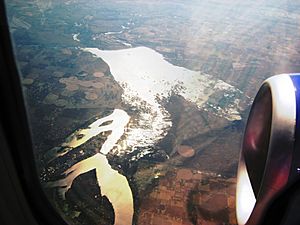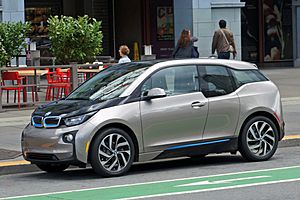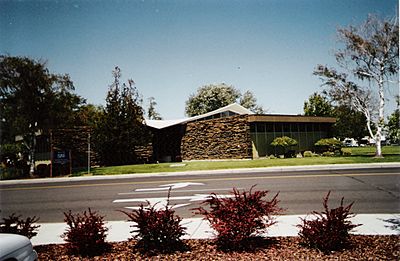Moses Lake, Washington facts for kids
Quick facts for kids
Moses Lake, Washington
|
|
|---|---|
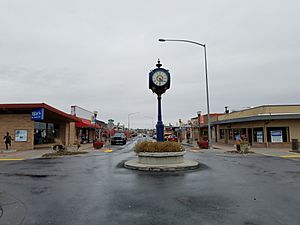
Downtown Moses Lake
|
|
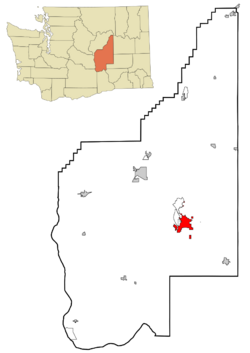
Location of Moses Lake in Grant County, Washington
|
|
| Country | United States |
| State | Washington |
| County | Grant |
| Founded | 1911 |
| Incorporated | September 15, 1938 |
| Government | |
| • Type | Council–manager |
| Area | |
| • City | 21.10 sq mi (54.65 km2) |
| • Land | 18.14 sq mi (46.97 km2) |
| • Water | 2.96 sq mi (7.67 km2) |
| Elevation | 1,070 ft (326 m) |
| Population
(2020)
|
|
| • City | 25,146 |
| • Estimate
(2023)
|
26,299 |
| • Density | 1,450.13/sq mi (559.89/km2) |
| • Urban | 38,751 |
| • Metro | 102,678 (US: 29th) |
| Time zone | UTC–8 (Pacific (PST)) |
| • Summer (DST) | UTC–7 (PDT) |
| ZIP Code |
98837
|
| Area code(s) | 509 |
| FIPS code | 53-47245 |
| GNIS feature ID | 1512481 |
Moses Lake is a city in Grant County, Washington, United States. It's the biggest city in Grant County. In 2020, about 25,146 people lived there. The city is part of a larger area called the Moses Lake Micropolitan area.
The city is located on a large lake also called Moses Lake. This lake is over 18 miles long and up to one mile wide. It's the biggest natural freshwater lake in Grant County. It has over 120 miles of shoreline and covers about 6,500 acres. Long ago, before dams were built, Moses Lake was smaller and not as deep. South of the city, you'll find the Potholes Reservoir and the Columbia National Wildlife Refuge. This area is home to many birds and other animals.
Contents
Exploring Moses Lake's Past
Before 1941, the area around Moses Lake was mostly empty land. Native Americans called this place Houaph, which means "willow." Chief Moses was a leader of the Sinkiuse tribe from 1859 to 1899. He had to make deals with white settlers who started moving into the area in the 1880s. The government eventually traded land with Chief Moses, giving his tribe a reservation that later became part of the Colville Indian Reservation.
The new settlers named the lake after Chief Moses. The city itself was first called Neppel, named after a town in Germany. Early settlers tried farming and fishing, but it was hard without enough water. Many people left as quickly as they arrived. When the town officially became a city and was renamed Moses Lake in 1938, only about 302 people lived there.
Things changed a lot when the Grand Coulee Dam was built in 1941. Then, the Moses Lake Army Air Base opened in 1942. These two projects brought many new people and opportunities to the area. Moses Lake quickly grew into an important center for travel, farming, and fun.
The Air Base and Its Impact
The air base was first used to train pilots during World War II. They learned to fly planes like the P-38 Lightning and B-17 Flying Fortress. After the war, the base closed for a short time. It reopened in 1948 as a U.S. Air Force base. It became a test area for new planes like the B-47 Stratojet. These tests helped create the modern jetliners we use today.
Today, the old air base is called Grant County International Airport. It's owned by the Port of Moses Lake. It's also home to Big Bend Community College and many businesses. For many years, Japan Airlines used this airport to train its pilots.
Farming and Growth
At the same time, farmers found new ways to get water from the lake and the Columbia River. When the Columbia Basin Project started bringing water in the mid-1950s, farms grew much larger. They started growing huge amounts of potatoes, corn, onions, and other vegetables.
Because of the air base and new farming methods, Moses Lake grew very fast. In just over ten years, the population jumped from 300 to 2,679 by 1950. By 2020, the city had grown to 25,146 people.
Moses Lake's Location
Moses Lake covers about 21.10 square miles (54.65 square kilometers). Most of this area is land, with about 2.96 square miles (7.67 square kilometers) being water.
Beautiful Scenery
Understanding the Population
The city's population has grown a lot over the years.
| Historical population | |||
|---|---|---|---|
| Census | Pop. | %± | |
| 1940 | 326 | — | |
| 1950 | 2,679 | 721.8% | |
| 1960 | 11,299 | 321.8% | |
| 1970 | 10,310 | −8.8% | |
| 1980 | 10,629 | 3.1% | |
| 1990 | 11,235 | 5.7% | |
| 2000 | 14,953 | 33.1% | |
| 2010 | 20,366 | 36.2% | |
| 2020 | 25,146 | 23.5% | |
| 2023 (est.) | 26,299 | 29.1% | |
| U.S. Decennial Census 2020 Census |
|||
In 2020, there were 25,146 people living in Moses Lake. There were about 9,564 households. Many different groups of people live in the city. About 36% of the population identified as Hispanic or Latino. About 28.7% of the people were under 18 years old.
Climate and Weather
Moses Lake has a dry climate, which means it doesn't get a lot of rain. It's called a semi-arid climate. Summers are warm, with temperatures often in the 80s Fahrenheit (around 27-32 Celsius). Winters are colder, with temperatures usually in the 30s Fahrenheit (around -1 to 4 Celsius).
July is the warmest month, with average high temperatures around 89.7 degrees Fahrenheit (32.1 Celsius). January is the coldest, with average low temperatures around 23.8 degrees Fahrenheit (-4.6 Celsius). The temperature can change a lot between day and night, especially in summer.
Moses Lake gets about 7.81 inches (198 mm) of rain each year. December is usually the wettest month. Sometimes, in mid-summer, there might be no rain for a month or more.
| Climate data for Moses Lake, Washington (Grant County International Airport) (1991–2020 normals, extremes 1949–1966, 1997–present) | |||||||||||||
|---|---|---|---|---|---|---|---|---|---|---|---|---|---|
| Month | Jan | Feb | Mar | Apr | May | Jun | Jul | Aug | Sep | Oct | Nov | Dec | Year |
| Record high °F (°C) | 60 (16) |
65 (18) |
75 (24) |
89 (32) |
97 (36) |
114 (46) |
109 (43) |
112 (44) |
100 (38) |
86 (30) |
70 (21) |
68 (20) |
114 (46) |
| Mean maximum °F (°C) | 52.2 (11.2) |
56.3 (13.5) |
68.2 (20.1) |
79.3 (26.3) |
89.9 (32.2) |
97.5 (36.4) |
103.1 (39.5) |
102.1 (38.9) |
93.3 (34.1) |
76.9 (24.9) |
62.5 (16.9) |
52.5 (11.4) |
104.5 (40.3) |
| Mean daily maximum °F (°C) | 36.4 (2.4) |
44.1 (6.7) |
54.9 (12.7) |
63.7 (17.6) |
73.7 (23.2) |
80.4 (26.9) |
89.7 (32.1) |
88.3 (31.3) |
78.7 (25.9) |
62.8 (17.1) |
46.3 (7.9) |
36.2 (2.3) |
62.9 (17.2) |
| Daily mean °F (°C) | 30.1 (−1.1) |
35.3 (1.8) |
43.3 (6.3) |
50.5 (10.3) |
59.5 (15.3) |
66.2 (19.0) |
73.4 (23.0) |
72.2 (22.3) |
62.8 (17.1) |
49.9 (9.9) |
37.6 (3.1) |
29.9 (−1.2) |
50.9 (10.5) |
| Mean daily minimum °F (°C) | 23.8 (−4.6) |
26.6 (−3.0) |
31.7 (−0.2) |
37.3 (2.9) |
45.4 (7.4) |
52.0 (11.1) |
57.2 (14.0) |
56.1 (13.4) |
47.0 (8.3) |
36.9 (2.7) |
28.8 (−1.8) |
23.5 (−4.7) |
38.9 (3.8) |
| Mean minimum °F (°C) | 8.2 (−13.2) |
14.3 (−9.8) |
21.4 (−5.9) |
25.7 (−3.5) |
32.7 (0.4) |
41.9 (5.5) |
47.8 (8.8) |
46.2 (7.9) |
36.0 (2.2) |
22.5 (−5.3) |
13.3 (−10.4) |
8.0 (−13.3) |
0.7 (−17.4) |
| Record low °F (°C) | −22 (−30) |
−9 (−23) |
1 (−17) |
21 (−6) |
25 (−4) |
37 (3) |
42 (6) |
42 (6) |
27 (−3) |
5 (−15) |
−19 (−28) |
−13 (−25) |
−22 (−30) |
| Average precipitation inches (mm) | 1.02 (26) |
0.65 (17) |
0.73 (19) |
0.65 (17) |
0.72 (18) |
0.73 (19) |
0.26 (6.6) |
0.15 (3.8) |
0.26 (6.6) |
0.66 (17) |
0.87 (22) |
1.11 (28) |
7.81 (198) |
| Average precipitation days (≥ 0.01 in) | 9.7 | 6.8 | 7.2 | 5.5 | 6.2 | 5.0 | 1.7 | 2.0 | 2.8 | 7.1 | 9.7 | 10.3 | 74.0 |
| Source: NOAA | |||||||||||||
Moses Lake's Economy
Moses Lake was traditionally known for its farming. But now, it also has a lot of factories and technology companies. Many businesses have moved here. For example, REC Silicon is one of the world's biggest makers of polysilicon, which is used in solar panels. Moses Lake has also attracted companies that make alternative fuels.
BMW, a famous car company, built a carbon-fiber factory here. Carbon fiber is a very strong and light material used in cars and other products. This factory started making carbon fiber in 2011. It has grown to be one of the largest carbon fiber producers in the world.
Several companies that make electric car batteries have also set up factories or research places in Moses Lake. This is because the area has good access to hydroelectric power (electricity from water) and materials needed for batteries. The U.S. Department of Energy has even given money to help build these factories.
Other big companies with facilities in Moses Lake include:
- Boeing (known for airplanes)
- Dell (computers)
- Sabey (data centers)
- Terex/AWP (Genie Industries) (heavy equipment)
- Guardian Industries (glass)
- ConAgra Foods (food products)
- Basic American Foods (food products)
- Moses Lake Industries
- J.R. Simplot Co. (food and agriculture)
- International Paper (paper products)
- Twelve (carbon transformation)
Media and News
- Columbia Basin Herald is the local daily newspaper.
- ifiber is a local company that provides internet services.
Getting Around Moses Lake
Roads and Highways
Two main highways pass through Moses Lake: Interstate 90 and State Route 17. Other roads, like State Route 171 and Interstate 90 Business, connect to the city center.
Trains
The Columbia Basin Railroad has its main office in Moses Lake. It runs the city's railroad and is very busy in Eastern Washington. There was once a plan for a fast train line between Seattle and Moses Lake. This would have helped use the Grant County International Airport as a backup airport for Seattle.
Buses
The Grant Transit Authority provides public bus service in Moses Lake and Grant County. You can take buses within the city or to nearby towns like Ephrata.
Airports
The main airport is Grant County International Airport. It used to be called Larson Air Force Base. It was a training center during World War II. Today, it's a huge airport used for training and testing large jets. Boeing, the U.S. military, and NASA use it. It has a very long runway, making it one of the largest airports in the United States.
Moses Lake also has a smaller airport called Moses Lake Municipal Airport. It has one runway and is used for smaller planes.
Learning in Moses Lake
Schools for All Ages
Moses Lake has many schools for students of different ages.
Elementary Schools
- Garden Heights Elementary
- Groff Elementary
- Knolls Vista Elementary
- Lakeview Terrace Elementary
- Larson Heights Elementary
- Longview Elementary
- Midway Elementary
- North Elementary
- Peninsula Elementary
- Park Orchard Elementary
- Sage Point Elementary
Middle Schools
- Frontier Middle School
- Columbia Middle School
- Endeavor Middle School
Private Schools
- AIM School and Gymnastics
- Glenn J. Kimber Academy
- Moses Lake Christian Academy
- Crest View Christian School
- Covenant Christian School
High Schools
- Moses Lake High School
- Vanguard Academy
- Digital Learning Center
- Columbia Basin Technical Skills Center (CBTech)
Learning Centers
- Family Services of Grant County / Head Start
- Skillsource
- Columbia Basin Job Corps Civilian Conservation Center
Colleges
- Big Bend Community College
Fun Things to Do
- Spring Festival: This festival happens every year around Memorial Day weekend.
- Moses Lake Water Sports Festival: Held in June, this festival celebrates water activities on the lake.
- Lion's Field: This sports field downtown was updated with new turf. It's used for soccer and football games.
- Brews and Tunes: This event started in 2018.
- Moses Lake Sand Dunes: These sand dunes are open all year for people who enjoy 4x4 vehicles and off-road riding. People come from all over to have fun in the sand.
Sister City Connection
Moses Lake has one sister city: Yonezawa, Japan. This special friendship started in 1978. On May 1, 1981, the mayors of both cities signed an agreement to become "Sister Cities."
As part of this program, high school students from Moses Lake and Yonezawa visit each other's cities every summer. This helps them learn about different cultures. Over 200 students and their families have been part of this exchange since 1981.
You can see signs of this friendship in Moses Lake. There's a street named Yonezawa Boulevard. You can also find special wooden carvings called Otaka Poppo, which are gifts from Yonezawa. Japanese lanterns, some given by people from Yonezawa, decorate Yonezawa Boulevard and the Japanese Garden in Moses Lake.
Famous People from Moses Lake
Many talented people have come from Moses Lake, including:
- T. R. Bryden, a baseball pitcher
- Jason Buck, a football player
- Matt Cedeño, an actor
- Ryan Doumit, a baseball catcher
- Clarence Gilyard, an actor known for Matlock and Walker, Texas Ranger
- Pierson Fodé, an actor
- Dave Heaverlo, a baseball pitcher
- Joe Hooper, a Medal of Honor recipient
- Reid Stowe, a sailor and adventurer
- Martha Thomsen, a model
- Kirk A. Triplett, a PGA golfer
- Joseph J. Tyson, a Roman Catholic bishop
- Bryan Warrick, a basketball player
- Alexys Nycole Sanchez, an actress
- Sid Eudy, a professional wrestler known as Sid Justice and Sycho Sid
- Rachell "Rae" Hofstetter, an Internet personality
Images for kids
See also
 In Spanish: Moses Lake (Washington) para niños
In Spanish: Moses Lake (Washington) para niños



